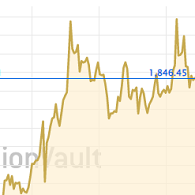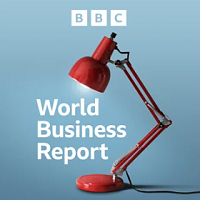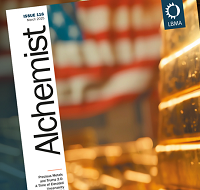JFK's Secret Reagan Revolution
Democrats now deny it, Republicans don't get it...
LARRY KUDLOW and Brian Domitrovic have teamed to up deliver a fantastic account of the
Kennedy tax reform of 1964,
writes Nathan Lewis of New World
Economics in this article first
published at Forbes.
That's all the more relevant today, as we
once again need leaders who
can "get the economy moving again," as Kennedy promised in the 1960 election.
If you have never heard the
tale before, you are in for a treat. Apparently, many have not, for the title of their book is JFK and
the Reagan Revolution: A Secret
History of American Prosperity. And if you have – I described the JFK tax cut briefly in Gold: the Once
and Future Money (2007) – you
are going to savor all the delicious details that Kudlow and Domitrovic have mustered of this wonderful
moment in US history. This one
goes on your must-read list.
While we generally remember the 1950s as a time of
economic good health (as
indeed it was, compared to what we have become used to since 1971), it was actually rather mediocre
compared to the astonishing
performance of the German or Japanese economies of the time, or the US expansion of the late
1960s.
Faced
with four debilitating recessions in eleven years, Kennedy focused on creating 5% real GDP growth in his
1960 election campaign. But
how?
Following the advice of Paul Samuelson, he assembled the leading lights of
academia, who told him that
he needed easy money and spending projects to take care of the unemployment (the solution John Maynard
Keynes had recommended in 1936)
and high taxes to prevent inflation. His Treasury Secretary Douglas Dillon, however, was a wealthy Wall
Street businessman wise to the
workings of the real economy, and also a Republican. Dillon supported the extensive research of the
little-known Stanley Surrey, a
member of the faculty of the Harvard Law School – not, it should be noted, an "economist", although he
was later called "the greatest
tax scholar of his generation," with twenty books to his credit.
Surrey argued
that the 91% top income tax
rate of the time was a "phantom rate" that nobody paid: as inevitably happens wherever high nominal
rates are found, lobbyists had
been hired to punch extensive loopholes in the tax code. Lower rates, he argued, would change incentives
and produce more growth.
Kennedy actually experimented with the advice of his academics, before disregarding them for the path
shown by Dillon and Surrey. The
result was a tax reform that lowered the top rate to 70% and all other rates proportionally; and the
best economic boom of the 1950s
and 1960s.
The first Reagan tax reform of 1982 was basically an exact copy of
Kennedy's 1964 tax cut. This
was deliberate, to help raise the needed support in the Democrat-controlled Congress. A substantial
number of Democrats used to
understand that the first and best thing to be done for the middle- and below-middle classes was to
create the private-sector economic
growth that could lead to rising employment and wages. In 1982, the first Reagan tax reform bill split
both parties, 103 to 89 among
Republicans and 123 to 118 among Democrats. The top income tax rate fell to 50%, again with proportional
reductions in all tax
brackets.
As Kudlow and Domitrovic recall, Reagan's 1986 tax reform, which
lowered the top Federal income tax
rate to 28%, passed the Senate with a vote of 97-3. Edward Kennedy, Joe Biden, Paul Sarbanes, Chris
Dodd, Al Gore Jr. and John Kerry
all voted for it. The plan for the tax reform had actually been hatched in the House Ways and Means
committee in 1985, led by
Democrats Dan Rostenkowski, Richard Gephardt and Bill Bradley.
Today, Democrats
(including, apparently, the
Kennedy family itself) refuse the idea that Kennedy and Reagan were following the same playbook; or that
Democrats voted for all three
tax reforms in large numbers. Kennedy's academic economists, who gave completely opposite advice and
were then brushed aside, later
claimed to be the source of the plan.
None of Kennedy's successors embraced his
breakthrough insights: both
the Democrat Lyndon Johnson and the Republican Richard Nixon raised taxes and attempted to deal with the
recessionary consequences
with easy money – the Paul Samuelson/James Tobin playbook. Republican Gerald Ford and Democrat Jimmy
Carter didn't do much better. By
that time, tax increases were coming about automatically via inflationary "bracket creep". This was
understood at the time, and not
exactly opposed by the political elites. An "accommodative" Federal Reserve was expected to keep the US
out of recession; the result
was stagflationary collapse.
Thinking has have moved on since then. Flat tax
reforms, which would lower the
top income tax rate to sub-20% levels while eliminating 90%+ of the tax code, take Surrey's original
insights to an idealized state.
The results would be awesome. How do we know this? Because over thirty governments worldwide have
already implemented "flat tax"
reforms since 2000, with universally fantastic results. The biggest beneficiaries are those who don't
pay taxes at all: unemployment
is still tax-free. A strong private economy is the only reliable source of job creation.
As Kudlow and
Domitrovic relate, the Kennedy success was not just about tax reform. It was a "policy mix" – in
particular, a rejection of the
academics' "easy money" strategy, in favor of a strong and stable currency.
"Strong and stable" means a gold
standard. Kennedy was a defender of the Bretton Woods gold standard of his time; Reagan wanted to bring
it back. The most successful
governments of the Bretton Woods era, Germany and Japan, also embraced a hard-money strategy, defending
stable exchange rates with the
Dollar, and thus to gold. Britain and France tried to boost their laggard economies with "easy money"
tricks; the result was periodic
currency devaluations.
Indeed, it was Richard Nixon's easy-money plan that
finally ended the world gold
standard in 1971, and ushered in a decade of "stagflation" as the kickoff for over four decades of
floating-fiat chaos. Nixon followed
Milton Friedman's monetary advice: in particular, a nominal GDP target of 9% in 1972, to be achieved
with the Federal Reserve's
printing press. The goal was achieved: 9.8% in 1972. The Dollar fell nearly to half its prior value in
the process. Friedman's
intellectual grandchildren today want to systematize Nixon's Big Idea in the form of a mechanistic
"nominal GDP targeting" system,
albeit one with – as suits today's low expectations – a nominal GDP target of perhaps 3.65%.
Kennedy's
hard-money/tax-cut strategy produced nominal GDP growth of 9.6% in 1966, without any "easy money" or
consequent devaluation of the
gold-linked Dollar. This was good, but much more was possible. Japan, which had cut taxes every year
since 1950, had nominal GDP
growth of 18.4% in 1968 – with a strong and stable gold-based Yen. Between 1950 and 1970, Japan's tax
revenue increased by sixteen
times, thus funding the expansion of a broad swath of welfare benefits that nobody needed because
unemployment was vanishingly small.
(The official rate for 1968 was 1.2%.) And what if Japan had enacted a Steve Forbes-style flat tax in
1964? Even more amazing things
would have happened.
Stanley Surrey, the brains behind the Kennedy tax cut, had
actually been in Japan in
1949-1950, to reform Japan's tax code. In 1949-1950, the Japanese government not only reduced the top
income tax rate to 55% from 85%,
it eliminated an excess profits tax, reduced corporate taxes, eliminated a national sales tax, banned
all government bond issuance and
repegged the hyperinflationary Yen to gold.
This is the power of the Magic
Formula: Low Taxes and Stable
Money, the "policy mix" that Kennedy discovered, as did Andrew Mellon before him and Ronald Reagan
afterwards. We don't really have to
"discover" it anymore, just put it to use; it lies idle, waiting for someone to come along who actually
wants to make America great
again.
I hope that we will see more books of this caliber from Brian
Domitrovic. The legions of PhD-wielding
mediocrities populating universities all seem to want to be the next Paul Samuelson.
Also: are there any
other geniuses hiding in the faculty of Harvard Law?












 Email
us
Email
us
